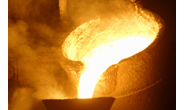International Steel Mills

Chinese “Zombie” Mills Produce for Sake of “Social Stability”
Written by Sandy Williams
January 17, 2016
There are zombie factories in China. No, they are not making zombies but the factories themselves are the equivalent of the walking dead–steel mills hanging on by a thread, not making money, reducing workforces, but clinging to life when they are all but dead.
The China Iron and Steel Association (CISA) is painting a grim picture for China’s steel industry with forecasts for continued falling steel consumption as the economy enters “a new normal.”
Mr. Zhang Guangning chairman of CISA said, “In the past two years, some severely loss-making mills have suspended operation for a while, of which some had wanted to permanently close shop, But some local governments insisted they continue to produce for the sake of economic development and social stability. Some such firms’ cash flows are drying up and they are becoming zombie enterprises.”
Companies producing value-added steel products have been hit harder with falling prices than steels commonly used in the construction industry. It includes hot rolled plate, cold rolled steel and galvanized products intended for appliances, automobiles and ship building.
“As our nation’s economy enters a new normal, the steel intensity of our economic output will continue to fall. In years to come, apparent consumption will see a slow reduction trend resulting in severe imbalances among production capacity, output and consumption,” said Zhang.
Crude steel apparent consumption in China fell 5.5 percent to 645 million tonnes in the first eleven months of 2015, following a decline of 3.3 percent the previous year.
Overcapacity is still a major problem for the industry said Zhang. New production capacity continues to be added as mill projects started in China’s prosperous years are completed and commissioned. Just last year two major 10 million tonne projects were partially completed. Outdated mills are being phased out but the closures are slow as provinces reluctantly give up major employers and revenue.
Steel production output is falling slowing with a 2.1 percent decline in 2015 to 781 million tonnes and another 3.1 percent decline expected for 2016.
Charles Bradford of Bradford Research said Chinese data is always subject to revision. Data in China is revised for the previous year at the end of the following year, which can skew results making steel growth rates look smaller. Bradford also disagrees with how capacity is defined, saying it should be “what can actually be produced, not what theoretically is possible.”
With steel demand faltering at home the alternative has been to ship steel abroad—steel exports from China in 2015 increased to 112.4 million tonnes from 93.78 in 2014. However, Chinese exports are increasingly being met with tough trade restrictions to protect domestic production.
Bradford says although the U.S. steel industry hopes that trade cases will reduce imports from China and elsewhere, duties that are less than ten percent do not affect trade. The recent Brazil determination of countervailing duties for hot rolled coil is an example at 7.42 percent.
Bradford agrees that China production has to be cut. “Present production cannot be sustained, it has to slowdown.” Part of the problem will be logistics. Railroads were built to handle freight from manufacturing expansion and then trains were made to go faster resulting in more accidents. Much of the freight in China is moved by river, “but you can’t build more rivers” he said.
Bradford says the latest comments by CISA are nothing new. The same discussions over capacity were made in 2006. At that time capacity was expected to reach 1.0 billion tonnes by 2020. They are ahead of schedule, said Bradford. Bradford Research is forecasting China steel production at 806 million tonnes for 2015 and a reduction to 780 million tonnes in 2016.
Despite calls by the Central government to reduce steel production in China, the 29 provinces tend to act independently, not always complying with directives. Bradford related a story about a Chinese steel producer that had all of his mills slated for closure on a government list. When asked how he would remain in business, the answer was “I’m expanding.”
The story is not uncommon said Bradford. In order to get a permit for a new mill in China, other capacity in the area must be shut down. If there is an order, for example, for mills producing at 10 million tonnes to be closed, then the producer does so and opens one at 20,000 tonnes, defeating the purpose of the policy but going along with the rules.
The mindset of maximum employment and economic growth driving overcapacity is not likely to be changed soon. Employment levels and growth are social issues that keeps the government in power and the population complacent, said Bradford. China has set a growth target of at least 6.5 percent annually for the next five years and keeps Inflation levels below 4 percent.
China Premier Li Keqiang said in a meeting with business leaders in November, “We have capacity to keep annual economic growth at above 6.5% and meet the targets of creating a ‘moderately prosperous society’ by 2020.”

Sandy Williams
Read more from Sandy WilliamsLatest in International Steel Mills

Global steel mill output steady through May
Global raw steel production rose 2% from April to May, slightly above average production levels seen in recent months, according to data recently released by the World Steel Association (worldsteel).

Trump says US government to control 51% share in USS
President Trump says the US government will hold a 51% stake in U.S. Steel after the Nippon deal.

USS, Nippon Steel quiet as litigation deadline approaches
There has been little word from U.S. Steel, Nippon Steel, or the White House since President Trump endorsed the companies’ “partnership” on social media and celebrated it at the May 30 rally outside Pittsburgh.

Ternium’s Vedoya named AIST’s Steelmaker of the Year
Maximo Vedoya was awarded in recognition of Ternium’s expansion project in Pesquería, Mexico, and Ternium’s efforts to decarbonize steelmaking.

CRU: Baosteel hints at output cuts in China
Baosteel exec comments on market rumors of 50 million tons of output being cut this year, less than 0.5% of the 1 billion tons-plus China has produced annually in recent years.
